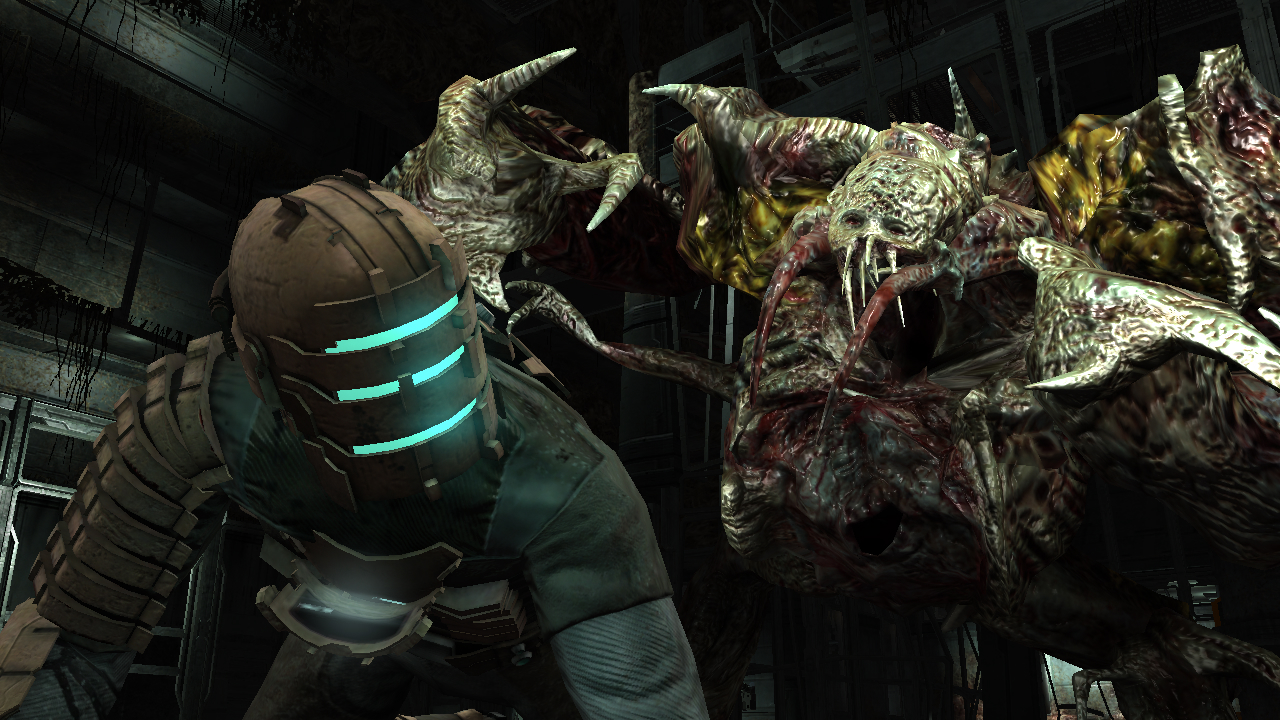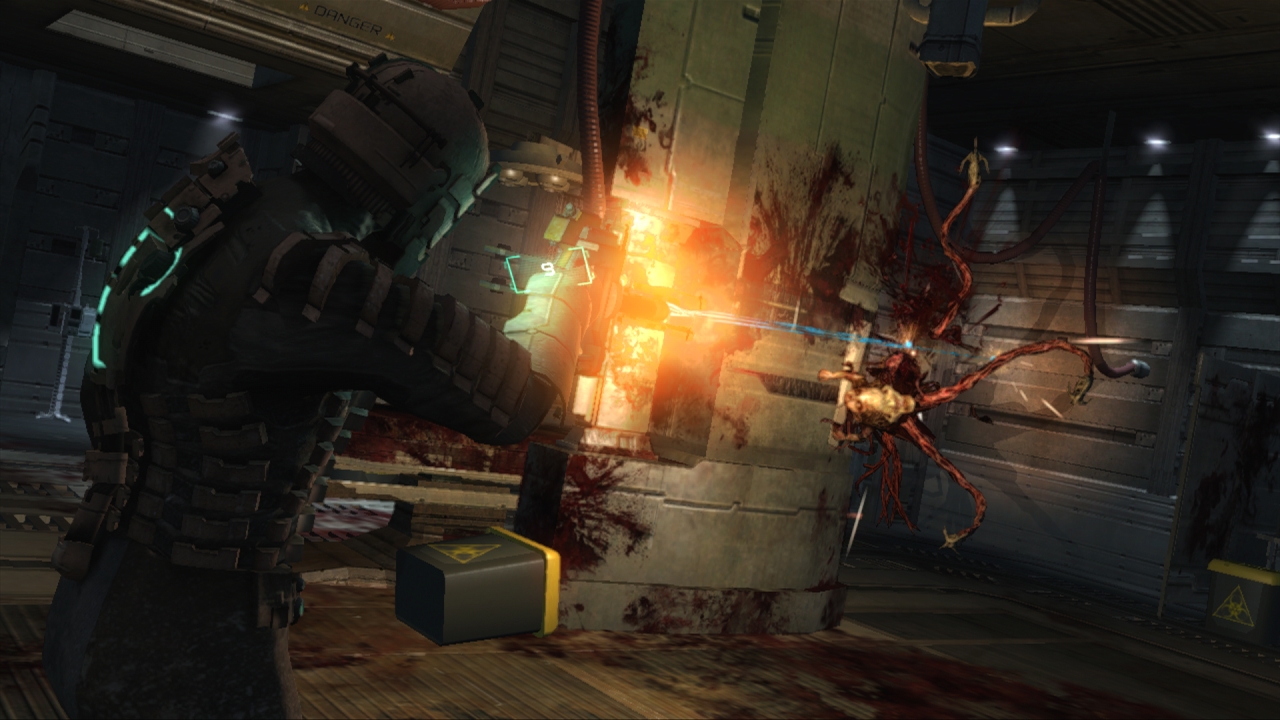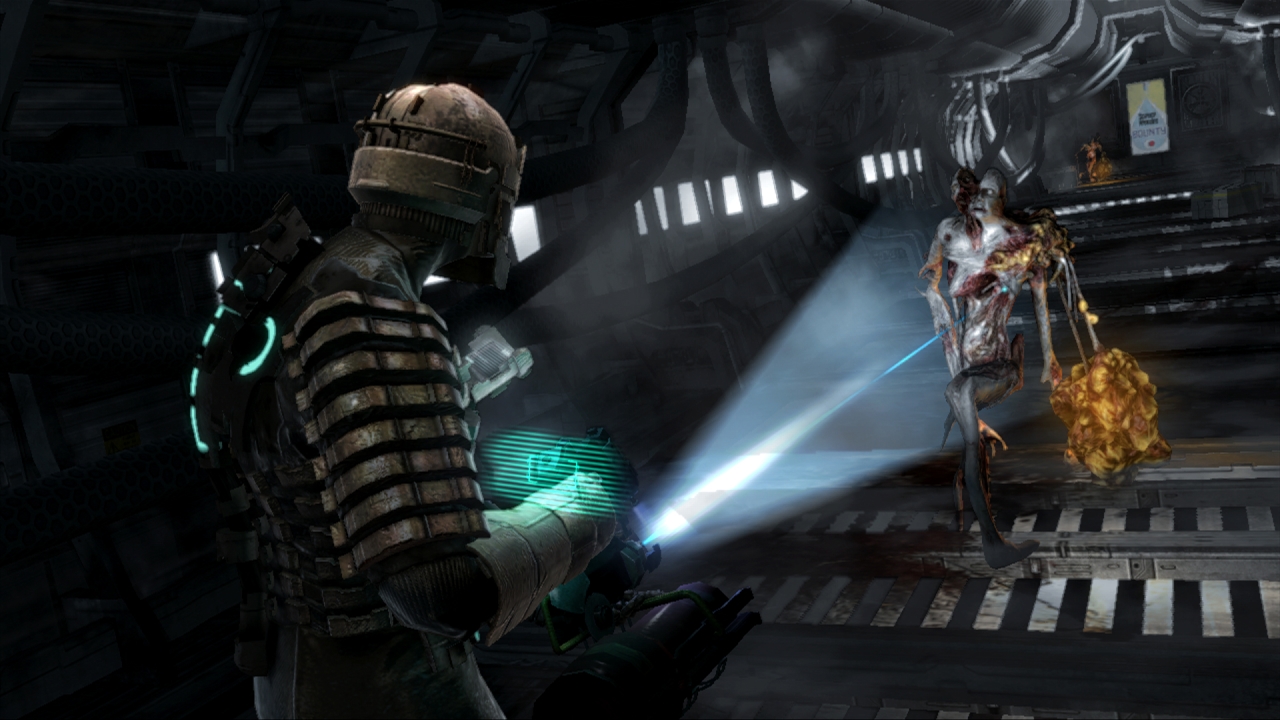Dead Space – Bloody, Brilliant & Innovative. But Is It Horror?
 When it was released in 2008, Dead Space was the deserving recipient of a plethora of awards including IGN’s award for “Best New Intellectual Property”. In its end-of year rundown, IGN breathlessly hailed Dead Space as “one of the most harrowing tales of the year”, citing the good ship Ishimura’s “dread and despair” as the game’s greatest strength.
When it was released in 2008, Dead Space was the deserving recipient of a plethora of awards including IGN’s award for “Best New Intellectual Property”. In its end-of year rundown, IGN breathlessly hailed Dead Space as “one of the most harrowing tales of the year”, citing the good ship Ishimura’s “dread and despair” as the game’s greatest strength.
It’s hard to argue with that. Dead Space‘s cover art features a disembodied arm floating above a battered spaceship, a compelling image of “dread and despair” if ever there was one. The game’s unlikely selling point was the fact that the gruesome enemies (“Necromorphs”) needed to be dismembered, rather than disemboweled. Timelessly enjoyable though shooting games are, even the keenest enthusiast can grow tired of executing endless head shots, so this relatively small innovation was surprisingly refreshing and translated into sales as well as plaudits.
But whilst Dead Space‘s credentials as a brilliant, bloody and innovative game are unquestionable, its status as a true horror game is up for debate. Although the concept – lone astronaut must dismember waves of mutants aboard abandoned mining vessel – ticks all the genre boxes, Dead Space lacks a few crucial elements that would have made it truly terrifying.
To find out what these are, let’s start by looking at what makes videogames scary.
One of the primary reasons we play games is because we wish to escape from an uncertain world in which circumstances over which we have no control frequently conspire to prevent us making progress through life. I’m really sorry if you’re reading this on a Monday morning. Maybe get a cup of tea and some biscuits before you continue!
Anyway, it’s not like that in video games. In video games, the entire universe has been created for our enjoyment. What could possibly be more reassuring than that?
Well, not much really, which is why scary games need to undermine this sense of security in order to make gamers feel uncomfortable. To be truly rattled, gamers need to believe that they’re intruding upon a hostile universe where they don’t belong.
That’s why the most unsettling video games fall squarely into the “survival horror” bracket, which are deliberately difficult and counter-intuitive to create a sense of powerlessness. Common tropes in the survival horror genre are fragile weapons, a slow-moving protagonist, a scarcity of med-kits and grotesquely powerful monsters. Yikes.

Survival horror games like Alone in the Dark (1992) and Dino Crisis (1999) were awkward and difficult on purpose. Unlike Doom (1993), Alone in the Dark‘s protagonist (Edward or Emily, depending on your preference) was not equipped with a vicious arsenal and was unable to maneuver at speed. Resident Evil (1996) provided the player with hardly any ammunition and players of Silent Hill (1999) were often better off running away from enemies than trying to take them on.
These games do feature spooky plots, but it’s the gameplay which really makes the heart beat faster. Unlike Dead Space, survival horror games don’t tend to allow the player to stockpile medkits and ammunition as a buffer against anything that might attack them. By never allowing the player to feel comfortably prepared for an encounter these games are perpetually unsettling.
That’s not something that ever troubles Isaac Clarke, bucket-headed protagonist of Dead Space. For a start, he is able to carry a fairly hefty array of unbreakable weapons and a good supply of ammunition. He’s also decked out in upgradable armour. Most conveniently of all however, he is miraculously well-equipped to perform precisely the kind of sinew-ripping surgery that the Necromorphs need in order to send them to a better place.
Unlike Silent Hill‘s protagonists (normal people adrift in a hostile environment), Isaac is an engineer with a lifetime’s training in blowing things up, setting them on fire or ripping them to shreds. These are skills that make him feel right at home on the Ishimura.
This is not to say that Dead Space is unimaginative. In a refreshing change from the hoards of faceless grunting space marines that came before him, Isaac is a faceless grunting space engineer. This means that instead of the ubiquitous quintet of weapons so frequently found in shooters (pistol, shotgun, assault rifle, sniper and rocket launcher), Dead Space features a gruesomely effective array of mining tools which Isaac can turn upon the Necromorphs to devastating effect. The Plasma Cutter (initially a tool for slicing through rock) features a plasma “blade” which can be flipped vertically or horizontally in order to dismember a flailing Necromorph. And the Contact Beam was designed to pound minerals and ore into smaller pieces. Guess what Isaac does with it?

Although Dead Space‘s script would have you believe that Isaac reluctantly uses his mining expertise to dispatch the Necromorphs, the sheer convenience of the tools he finds scattered around makes the Ishimura feel as much like a playground as Halo’s colourful jungles. Because the Necromorphs don’t really respond to being shot in the head or the torso, a soldier’s skill with a shotgun wouldn’t be that effective, so it’s actually just as well Isaac’s an engineer who’s skilled with a buzz saw. Consequently, the uncomfortable sense of trying to navigate a hostile universe, usually so prevalent in survival horror, never really troubles Dead Space.
As far as gameplay goes, this is not a problem. Slaughtering Necromorphs is so much fun that you’re glad the game mechanics don’t get in the way when you’re trying to do so. Isaac is also equipped with a superhuman “stasis” ability which enables him to freeze the Necromorphs mid-wriggle and pick off their limbs at leisure. I can’t overstate how enjoyable this is, but I’d be the first to admit that it’s not very scary. Even on “hard” difficulty, the odds still feel stacked in Isaac’s favour, so the player never really feels particularly besieged by the Dead Space universe.
But does that matter? Does Dead Space‘s gift of convenient engineering tools make the game any less fun? It would make a traditional survival horror game less fun, that’s for sure. The joy in a game like Silent Hill comes not from laboriously beating monsters to bits with a rusty pipe, but from having done so and surviving to tell the tale.
Horror games keep the player in a state of hair-triggered suspense for as long as possible before putting them through a horrific ordeal. The joy of such games comes from the flood of relief at having defeated a monster, not from the visceral joy of doing so.
To put this in context, at the other end of the scale is the FPS. We play FPSs because we like shooting. We like executing headshots and a good FPS provides an abundance of varied targets for us to dispatch. Despite being a third person game with only one “proper” gun, Dead Space has far more in common with an FPS than with the survival horror games it initially seems to be so closely related to. It provides us with enemies so we can have fun picking them off, not to terrify us.
Even though Dead Space’s gameplay is devoid of any real horror, its storyline is still littered with enough “horror” tropes to fill the basement of any bargain video store. Whether or not these make the game truly scary is another matter, but it’s worth delving around and seeing what we come up with.

Let’s see: protagonist alone with no hope of rescue (check); evil cult (check); megalomaniac scientist (check); line man was not meant to cross (check); hideously mutated humans locked in eternal torment with only the cold embrace of death to look forward to (check, check and check).
Pretty scary stuff, right? And yet unlike comparable protagonists (most obviously Alien‘s Ripley) who are traumatised by the events they experience, Isaac never seems particularly affected by Dead Space‘s human tragedy.
Part of the problem is the inscrutability of that helmet, which not only stops him talking, but also displaying any emotion, even when his beloved girlfriend Nicole is in peril. He grunts a bit when he’s getting chewed on by an errant Necromorph, but he never thinks to engage in conversation with any of the antagonists or tell his panicking girlfriend that he loves her.
Consequently, it’s impossible to identify with him. If Dead Space used gameplay to create a tangible sense of peril this wouldn’t matter, but as we’ve established, Dead Space‘s gameplay is mainly about making a mess. This means that Isaac’s apparent indifference to the events unfolding around him serves to alienate not only poor old Nicole, but also the player.
The most terrifying video games have much in common with horror stories in other media, in that they expose the dark psychological chasms that exist within us all in order to scare us. Dead Space points out the chasms from its cushioned tour bus, but it never really takes us inside.
Compare it to Silent Hill 2, in which the self-destructive protagonist, James, only rocks up to Silent Hill in the first place because he can’t remember whether he killed his wife or not. An apparently bland character in desperately boring clothes, James’ inability to either a) leave the disturbingly sexual Maria well alone or b) run away when he comes across sado-masochistic mutant orgies reveals something rather dark and nasty at his core. Although his culpability for the events around him are left largely open to interpretation, his willingness to involve himself in them is what makes the game so sick-makingly scary.
In start contrast to James, Isaac bumbles around the Ishimura picking up ever-more powerful weapons and never really acknowledging the pathetic sadness of the once-human Necromorphs or the activities of the Church of Unitology. He only ever interacts with his surroundings in order to destroy it and while destroying the Isimura is, on balance, probably a good idea, Isaac’s refusal to engage with it means that the player never gets to either.

It’s difficult to say whether Dead Space would be a better game if it was scarier. It would be scarier if Isaac were a more believeable character, but then he’d probably only be able to carry one weapon at a time and this would probably be a rusty pipe rather than a Plasma Cutter. But then the joy of Dead Space is in playing with Isaac’s ever-more preposterous arsenal.
Besides, without the Plasma Cutter, the Ripper and the rest, the leggy ingenuity of the Necromorph’s anatomy would be wasted. Have you ever tried to hack off a limb with a crowbar? Me neither.
Perhaps games with fun, intuative combat mechanics can never be truly scary. Think of F.E.A.R. (2005), the FPS in which the main character is equipped with reflexes that enable him to perform complex manouevers in slow motion. These sequences are deliciously satisfying and look incredible – sparks spiral from grenades, bullets ripple as though underwater – but the ease with which the player can execute them robs F.E.A.R. of all its horror.
Like F.E.A.R., Dead Space‘s gleefully gruesome central mechanic results in a game which is about as scary as a paint-ball fight, albeit no less enjoyable. I did scream whilst playing it, but it was the scream of a theme-park visitor, exhilerated by a sudden drop or a swoop in the track. Dead Space might have been scarier if it featured fewer opportunities to pick off the phallic arm of a squirming Necromorph in slow-motion with a convenient mining implement, but then it would also have been less fun.
The lack of a truly involving story makes Dead Space less than perfect. Its protagonist is forgettable and its plot disposable. Furthermore, the game is robbed of all tension by a contrived combat mechanic. But despite being such an obstruction to the plot, this contrived mechanic is what makes Dead Space so enjoyable. If it’s ten hours of exhilarating, sticky destruction you’re after, you’d be hard-pressed to do better.
Is Dead Space a true horror game? Well, no, but the things that rob it of this honour are the very things that make it such a blast. Dead Space‘s striken-mining-vessel-in-space-with-zombies aesthetic is crucial to its squelchy appeal, and if larking about with a ripper makes it more silly than scary, than that’s a sacrifice it should be pleased it made.





